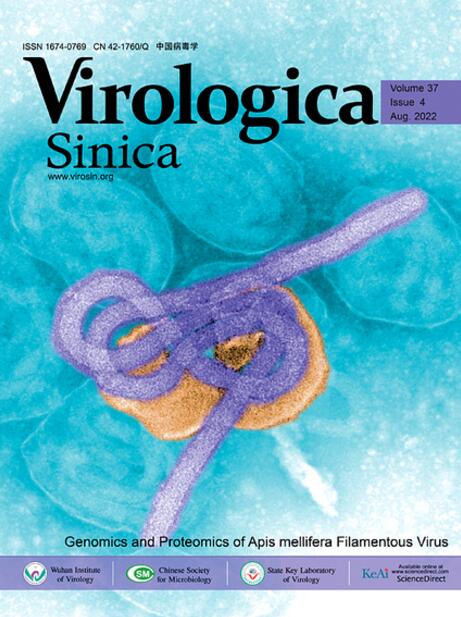宿主因子RBM25通过阴阳1介导的cccDNA转录促进HBV复制。
IF 5.5
3区 医学
Q1 Medicine
引用次数: 0
摘要
在乙型肝炎病毒(HBV)感染的肝细胞中,共价闭合环状DNA (cccDNA)的持续存在仍然是有效抗病毒治疗的主要障碍。了解调节HBV cccDNA转录的分子机制对于开发新的治疗策略至关重要。在本研究中,我们研究了RNA结合基序蛋白25 (RBM25)在HBV复制中的作用,重点研究了其与cccDNA的相互作用及其对宿主转录因子的调控。结果表明,RBM25敲低显著抑制HBV复制,降低HBV复制和感染细胞模型中HBV DNA、乙型肝炎e抗原(HBeAg)、乙型肝炎表面抗原(HBsAg)、HBV RNA和l - hbbs的水平。在水动力注射1.2×HBV质粒的小鼠模型中观察到一致的结果。相反,RBM25过表达显著增强HBV复制。机制上,RBM25通过其RE/RD和PWI结构域与cccDNA结合,促进HBV启动子活性。这种作用是由阴阳1 (YY1)表达增加介导的,YY1表达增强cccdna结合组蛋白的乙酰化,促进HBV转录。此外,随着核心蛋白的表达和积累,RBM25表达上调并易位至细胞核,而过表达RBM25促进核心蛋白降解。总之,本研究表明RBM25是一种新的宿主因子,通过上调yy1依赖性cccDNA的转录激活来增强HBV复制。它还揭示了HBV核心蛋白和RBM25之间的互惠调节机制,这有助于维持HBV的复制。本文章由计算机程序翻译,如有差异,请以英文原文为准。
Host factor RBM25 promotes HBV replication through Yin Yang 1-mediated cccDNA transcription
The persistence of covalently closed circular DNA (cccDNA) in hepatitis B virus (HBV)-infected hepatocytes remains a major obstacle to effective antiviral treatment. Understanding the molecular mechanisms regulating HBV cccDNA transcription is essential for developing novel therapeutic strategies. In this study, we investigated the role of RNA binding motif protein 25 (RBM25) in HBV replication, focusing on its interaction with cccDNA and its regulation of host transcription factors. The results demonstrated that RBM25 knockdown markedly inhibited HBV replication, reducing levels of HBV DNA, hepatitis B e antigen (HBeAg), hepatitis B surface antigen (HBsAg), HBV RNA, and L-HBs in HBV-replicating and infected cell models. Consistent results were observed in a mouse model hydrodynamically injected with 1.2 × HBV plasmid. Conversely, RBM25 overexpression significantly enhanced HBV replication. Mechanistically, RBM25 promoted HBV promoter activities by binding to cccDNA through its RE/RD and PWI domains. This effect was mediated by increased Yin Yang 1 (YY1) expression, which enhanced acetylation of cccDNA-bound histones, promoting HBV transcription. Furthermore, RBM25 expression was upregulated and translocated to the nucleus following core protein expression and accumulation, while overexpression of RBM25 promoted core protein degradation. In conclusion, this study demonstrates that RBM25 is a novel host factor that enhances HBV replication by upregulating YY1-dependent transcriptional activation of cccDNA. It also reveales a reciprocal regulatory mechanism between the HBV core protein and RBM25, which helps sustain HBV replication.
求助全文
通过发布文献求助,成功后即可免费获取论文全文。
去求助
来源期刊

Virologica Sinica
Biochemistry, Genetics and Molecular Biology-Molecular Medicine
CiteScore
7.70
自引率
1.80%
发文量
3149
期刊介绍:
Virologica Sinica is an international journal which aims at presenting the cutting-edge research on viruses all over the world. The journal publishes peer-reviewed original research articles, reviews, and letters to the editor, to encompass the latest developments in all branches of virology, including research on animal, plant and microbe viruses. The journal welcomes articles on virus discovery and characterization, viral epidemiology, viral pathogenesis, virus-host interaction, vaccine development, antiviral agents and therapies, and virus related bio-techniques. Virologica Sinica, the official journal of Chinese Society for Microbiology, will serve as a platform for the communication and exchange of academic information and ideas in an international context.
Electronic ISSN: 1995-820X; Print ISSN: 1674-0769
 求助内容:
求助内容: 应助结果提醒方式:
应助结果提醒方式:


